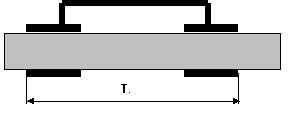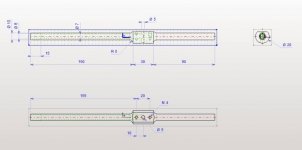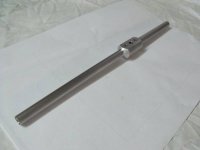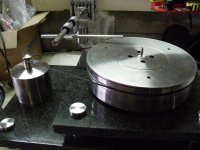.087 is the Tangent of the angle at which the carriage starts to move. And that is the coefficient of friction for that bearing and shaft combination.
If you have a scientific calculator, type in 5 (degrees) and press the tangent key.
Sincerely,
Ralf
Then it is possible to divide the the forces in three directions. And the forces are the result of the weight of the assembly and gravity.
So when it moves at a angle it is the result of the weight and friction. Doesn't say anything about the side force on the stylus.
Hi Doug, I agree with you 100%. That's why I have cleaned the bearings, and later, I will do the system with weight and pulley which help the sliding.DIM,
Normal circular bearings work best very clean and dry, without lubrication, in LT arms. I know very little about linear bearings, but you may find they also work best without lubrication.
I'm looking forward to the completion of your arm.
Doug Tuthill
Hi ralf,If the carriage starts to move at 5 degrees, that is a coefficient of friction of .087 which is way too high. An ABEC 7 instrument ball bearing has a coefficient of friction of only .004. Once you add the tone arm and its counterweight the coefficient of friction will likely go down. I agree with "dtut" that lubrication would matters worse. Did you make sure one of the ball circuits in each linear bearing is located at top dead center i.e. 12 o'clock?
Also, do you intend to use the linear bearings for the vertical motion of the tone arm?
If you can't reduce the coefficient of friction, you may have to design a new carriage, using individual instrument ball bearings.
Sincerely,
Ralf
The linear bearings alone can't work perfectly, that's wright. I will test the translation with pulley and weight, and then even modify the chariot for 4 ball bearings, easy for me to do.
Hi Helmuth,I do not know how much 0,087 is in gram but it may have 1,5 gram force to move, it would me perfect.
I think to make that assembly as light as possible is also a must, to let the arm follow a not perfect flat record. And to reduce friction and the forces that come with the friction. The assembly is unnecessary bulky now. Make it hollow on the bottomside is maybe a good idea.
It would also possible to reduce the construction to one linear ball bearing, instead of the two you need with this construction.
The only reason that I choose 2 linear bearings is to reduce the blocking cause (see photos). When you have a linear translation, you must take care of this relation: L>2,5D, more distance you have, better will be the translation, and of course you have double bearing torque, I hope the pulley and the weight will decrease this translation torque.
Attachments
Hi, Doitmyself. As to linear designs, they all seem to be pretty problematic, with some permanent problems inherited and still unsolved. IMHO, semi-linear designs, like old Garrard Zero 100, or modern Thales arm ,are worth trying, especially using natural materials such as wood and thread... I've always wondered, why Zero 100 design wasn't followed by it's improved version of a separate component, with it's own arm lift and mount, allowing to be installed on different turntables. Thales finally has those features, but it's price kind of really prohibitive...
Last edited:
walterwalter:"IMHO, semi-linear designs, like old Garrard Zero 100, or modern Thales arm, are worth trying, especially using natural materials such as wood and thread..."
I agree that linear tracking tonearms are problematic and I wish more experiments can be done with "semi-linear" designs by using pivot bearings combined, perhaps, with linear bearings. By using a traditional pivot arm and introduce an extra pivot at the headshell can keep things simple for DIYers, the creative part is in the guiding mechanism to keep the stylus tangent or close to tangent to the groove. Straightracker proposed an interesting design in a different thread. I also have another thread on such design if you want to check it out.
Here's one example.
Good luck with your project, doitmyself!
.
Straightracker proposed an interesting design in a different thread. I also have another thread on such design if you want to check it out.
Here's one example.
Good luck with your project, doitmyself!
.[/QUOTE)
Both threads are just amazing. Unbelievable lot of useful information. "One example" is exactly what I've meant: simple, effective and fine. Thanks a lot to you, Directdriver
I agree that linear tracking tonearms are problematic and I wish more experiments can be done with "semi-linear" designs by using pivot bearings combined, perhaps, with linear bearings. By using a traditional pivot arm and introduce an extra pivot at the headshell can keep things simple for DIYers, the creative part is in the guiding mechanism to keep the stylus tangent or close to tangent to the groove. Straightracker proposed an interesting design in a different thread. I also have another thread on such design if you want to check it out.
Here's one example.
Good luck with your project, doitmyself!
.
Hi Directdrive,
I had a look to the threads. Well, well, well. I think I had to make a small break to do a synthesis of all this. Some of you tried to make me understand how difficult is "making a tonearm". I didn't take care of basics mecanical laws. I was so impatient to build something which is my own DIY.
I have a small idea of a new tonearm, will post it soon.
Bruno
Hi Walterwalter,Both threads are just amazing. Unbelievable lot of useful information. "One example" is exactly what I've meant: simple, effective and fine. Thanks a lot to you, Directdriver
Yes, they're all astonishing.
I just have a big respect for these works.
Hi http://www.diyaudio.com/forums/members/doitmyself.htmlDoitmyself!
Tell me, what is due to the choice of marble on the case, you have investigated other materials for housing
Yours sincerely, Alex
Tell me, what is due to the choice of marble on the case, you have investigated other materials for housing
Yours sincerely, Alex
well, if you have to ask, then the weight will be "never enought". 
I loved this turntable. Very nicely done. Especially the motor and bearing.
I considered a Mitsubishi servomotor with controller directly coupled to a platter (DD), it would rotate very nicely and smooth but it was on 200watt (!!), and I was not complety sure if it would be a success (!!), so at best it would be a failure. (!!!) I wasn't (and still aren't!) complete sure how to measure noise, rumble and wow/flutter. (!!!)
Maybe another time. In meanwhile I'll buy turntables and drool on these DIY TT.
I loved this turntable. Very nicely done. Especially the motor and bearing.
I considered a Mitsubishi servomotor with controller directly coupled to a platter (DD), it would rotate very nicely and smooth but it was on 200watt (!!), and I was not complety sure if it would be a success (!!), so at best it would be a failure. (!!!) I wasn't (and still aren't!) complete sure how to measure noise, rumble and wow/flutter. (!!!)
Maybe another time. In meanwhile I'll buy turntables and drool on these DIY TT.
Hi Alex,Hi Doitmyself!
Tell me, what is due to the choice of marble on the case, you have investigated other materials for housing
Yours sincerely, Alex
Choice of "granite", and not marble is purely esthetic and opportunity ( the shop which has made the two platters didn't want me to pay it), for the other pars, all in stainless steel, and now I'm looking for the second next tonearm with thuya burle or even horn.
Bruno
Hi Rbanta, aprox 90 kg.May I ask, how much does it weigh?
Hi Doomy,well, if you have to ask, then the weight will be "never enought".
I loved this turntable. Very nicely done. Especially the motor and bearing.
I considered a Mitsubishi servomotor with controller directly coupled to a platter (DD), it would rotate very nicely and smooth but it was on 200watt (!!), and I was not complety sure if it would be a success (!!), so at best it would be a failure. (!!!) I wasn't (and still aren't!) complete sure how to measure noise, rumble and wow/flutter. (!!!)
Maybe another time. In meanwhile I'll buy turntables and drool on these DIY TT.
I use a motor only 30 W. It's largely enouth with a low acceleration time (5 seconds, because of the weigh of the platter). To measure the noise I'm also a newbe. I will just use a microphone putted against every component and recorded while turning. I will do the same measurements with a Technics TT to compare. I don't think it's a good way but it will give me good idea of what it is.
Bruno
- Status
- This old topic is closed. If you want to reopen this topic, contact a moderator using the "Report Post" button.
- Home
- Source & Line
- Analogue Source
- DIY Personal Turntable




